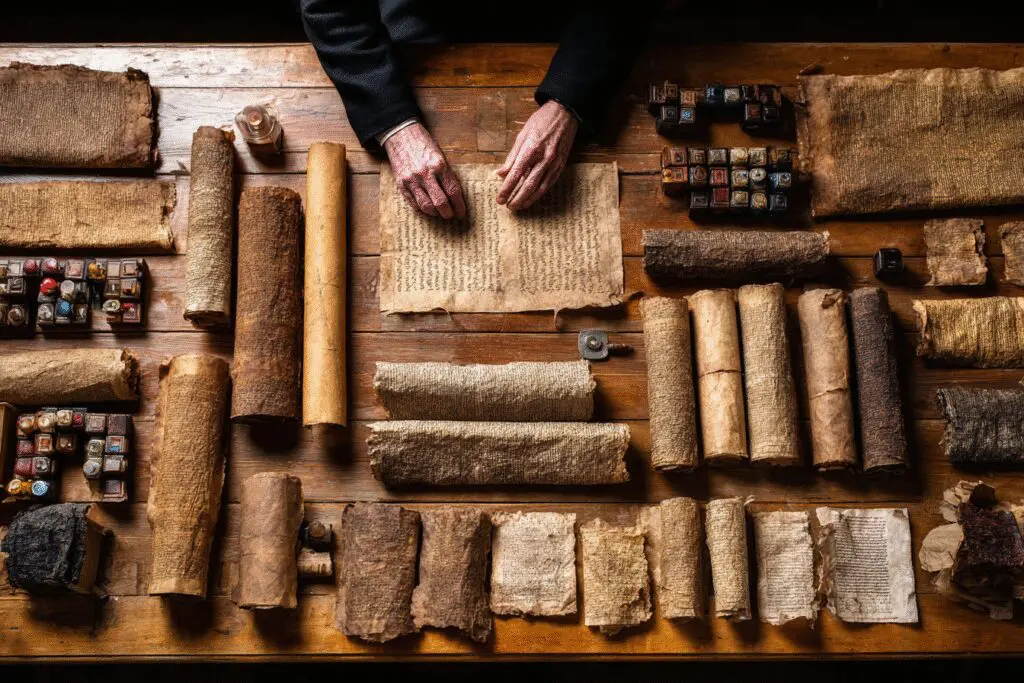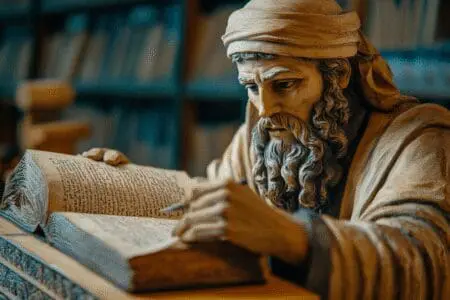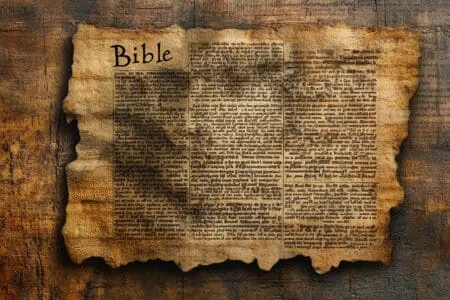Have you ever stood in a library and just looked at the sheer volume of books? Thousands of stories, histories, and ideas, all bound and organized on shelves. Now, imagine trying to create a library that would define the beliefs of billions of people, but you can only choose about 66 books. And you have to do it over a span of about 1,500 years, with hundreds of authors, multiple languages, and constant debate.
That’s essentially the story of the Bible.
We tend to think of the Bible as a single, cohesive book that just… appeared. But when you start to ask questions, you realize that can’t be right. Who decided that the Gospel of John was in, but the Gospel of Thomas was out? Who picked these specific letters from the Apostle Paul and not others? It’s a question that used to bug me because the Bible is presented as this monolithic authority, yet it was assembled by human beings. Understanding how was the Bible put together doesn’t feel like a theological question to me; it feels like a historical one, a human one.
This isn’t a story about a book falling from the sky. It’s a messy, fascinating, and deeply human story of debate, tradition, and a centuries-long effort by communities to figure out which texts truly told their story.
More in Bible Category
How Many Copies of Plato Survived Compared to the Bible
How Were the Books of the Bible Selected
Key Takeaways
Before we dive in, here’s the quick rundown for those of you who just want the highlights:
- It wasn’t a single event. The Bible was compiled over many centuries. There was no single “Bible committee” that voted on all the books at once.
- The Old and New Testaments were formed separately. The Hebrew Bible (the Old Testament) had its own long history of formation before Jesus was even born.
- There were more books than you think. Early Christian and Jewish communities read and valued many texts that didn’t end up in the final version of the Bible.
- People made the decisions. The final list of books (the “canon”) was the result of centuries of discussion and debate by church leaders, scholars, and everyday believers. They used specific criteria to make their choices.
- It was about identity. Choosing these books was an act of self-definition for both Judaism and Christianity, a way of saying, “This is who we are, and this is what we believe.”
Okay, So Where Did the First Part, The Old Testament, Even Come From?
Long before there were books, there were stories. The oldest parts of the Old Testament didn’t start as writing. They were oral traditions, stories told around campfires and passed down from one generation to the next—the grand epics of creation, the tales of Abraham’s journey, the dramatic exodus from Egypt. These were the foundational memories of the Israelite people.
Eventually, people started writing these stories down. This wasn’t a quick process. We’re talking about a slow burn over hundreds of years. The first five books, what Jewish tradition calls the Torah and Christians call the Pentateuch, were likely the first to be compiled into something resembling their final form. Think of it less like an author writing a novel and more like an editor compiling a massive anthology of a nation’s most important documents, laws, poems, and histories.
Who Were the Scribes Writing This Stuff Down?
When I hear the word “scribe,” I used to picture a guy hunched over a scroll, just mindlessly copying words. But that’s not the full picture. These scribes were more like scholar-editors. They were the ones gathering the various traditions, weaving them together, and shaping them.
They weren’t just preserving the past; they were interpreting it for their present. They had a point of view. They believed God was acting in the history of their people, and they compiled these texts to show that. It was a massive intellectual and spiritual project, driven by a desire to make sense of their world and their relationship with God. They weren’t passive recorders; they were active participants in the formation of the text.
So, They All Agreed on the Books?
Not exactly. Even in the ancient world, there wasn’t just one “version” of the Old Testament. For starters, around the 3rd century B.C., a Greek translation of the Hebrew scriptures was produced in Alexandria, Egypt. Legend has it that 72 scholars worked on it, so it was called the Septuagint.
Here’s where it gets interesting: the Septuagint included several books that were not in the Hebrew collection that eventually became the standard for Rabbinic Judaism. These “extra” books are what many Protestants today call the Apocrypha.
So why the different lists?
- Jewish rabbis, especially after the destruction of the Second Temple in 70 A.D., felt a pressing need to consolidate and define their sacred texts. They focused on the books originally written in Hebrew and those they believed were clearly inspired.
- The early Christian church, however, did much of its reading from the Greek Septuagint. It was their Bible. So, many of those “extra” books were included in early Christian Old Testaments.
This is a perfect example of how the Bible’s table of contents wasn’t set in stone. It was a living tradition, shaped by the needs and languages of different communities.
What Happened After Jesus? Was Everyone Just Writing Gospels?
The period immediately following Jesus’s life was one of explosive energy. The first Christians believed something world-changing had just happened, and they were eager to share it. Their primary method wasn’t writing books; it was telling stories and forming communities.
The very first Christian documents we have are not the gospels, but the letters of the Apostle Paul. He was writing to specific churches to solve problems, offer encouragement, and clarify his teachings. He had no idea he was writing what would become holy scripture. He was just a passionate leader trying to manage a rapidly growing, messy movement.
At the same time, stories about Jesus—his teachings, his miracles, his death and resurrection—were circulating orally. People who had known him, or knew people who knew him, shared these accounts. Over time, different authors began to collect these stories into the narrative accounts we now call the Gospels.
Why So Many Gospels? And Who Wrote Them?
We have four gospels in the New Testament: Matthew, Mark, Luke, and John. But in the first couple of centuries, there were many others, like the Gospel of Peter, the Gospel of Mary, and the Gospel of Thomas. Each one offered a unique portrait of Jesus.
So why did these four make the final cut?
- The Gospel of Mark was likely the first one written, a fast-paced, “just the facts” account.
- Matthew and Luke seem to have used Mark as a source, but they added more of Jesus’s teachings (like the Sermon on the Mount) and included the famous birth stories.
- The Gospel of John is different. It’s more theological, more reflective, painting a cosmic portrait of who Jesus was.
I try to imagine two early Christian communities in, say, 120 A.D. One in Rome primarily reads Mark, and another in Ephesus treasures the Gospel of John. Their understanding of Jesus might have subtle differences. The existence of these different accounts shows us that the early church wasn’t a monolith. It was a collection of diverse communities, each trying to understand Jesus in its own context. The four that were ultimately chosen were the ones that the widest number of these communities found to be the most reliable and powerful accounts.
So, Who Actually Got to Choose the Books?
This is the big question, isn’t it? The simple answer is that there wasn’t one person or one group. It was a long process of consensus-building that took centuries. There was no secret meeting in a smoke-filled room where a handful of bishops voted books in or out, despite what novels might tell you.
It was more like a book becoming a “bestseller” across the entire Roman Empire. Churches in different regions—from North Africa to Syria to Italy—began to use and cherish a certain collection of writings in their weekly worship services. The books that were read, copied, and circulated the most widely were the ones that gradually gained authoritative status.
Was There One Big Meeting Where They Voted?
The process was more organic than that, but there were key moments and people who helped push the consensus forward. A guy named Marcion in the 2nd century tried to create his own “Bible” by cutting out the entire Old Testament and keeping only a modified version of Luke and some of Paul’s letters. The mainstream church reacted strongly against this, which forced them to start thinking more seriously about what they considered the full story.
Church fathers like Irenaeus, a bishop in the late 2nd century, argued powerfully for the unique authority of the four gospels we now have, comparing them to the four corners of the earth and the four winds. He wasn’t issuing a decree; he was making a case, persuading his fellow Christians.
The first person to list, exactly, the 27 books that are in the modern New Testament was Athanasius, the influential bishop of Alexandria. In his annual Easter letter in 367 A.D., he listed them as the only universally accepted, inspired writings. He wasn’t inventing a new list; he was confirming a consensus that had been growing for generations.
What Were Their Rules for Deciding?
Athanasius and other church leaders weren’t just picking their favorite books. They were using a set of criteria that had developed over time to test a book’s authority. While never an official checklist, the core principles were pretty clear:
- Apostolic Connection: Was the book written by an apostle or someone in their immediate circle? They wanted a direct connection to the original eyewitnesses. Mark, for instance, was traditionally believed to be a disciple of Peter. Luke was a known companion of Paul.
- Widespread Use: Was the book being read and accepted by churches across the known world? A document that was only popular in one small town in Egypt wasn’t going to make the cut. They were looking for universal, not just local, appeal.
- Faithful Teaching: Did the book’s message align with the core Christian faith as it was understood and taught? This was a key test. It had to be consistent with the tradition handed down from the apostles.
- Divine Quality: This one is less tangible, but they believed certain texts just had a self-evident power to them—a sense that God was speaking through them.
Think of it as a multi-layered verification process. It had to come from the right source, be accepted by the community, teach the right message, and have that spark of divine inspiration.
Did Politics Play a Role? I Mean, Come On.
Of course, it did. You can’t separate history from politics, and the story of the Bible is no exception. For the first few hundred years, Christianity was a fringe, often persecuted, religion. That all changed with the Roman Emperor Constantine.
After he converted to Christianity in the early 4th century, he wanted a unified church to help unify his sprawling empire. He convened the Council of Nicaea in 325 A.D. Now, the main purpose of this council wasn’t to pick the books of the Bible. It was to settle a huge theological dispute about the nature of Jesus Christ (the Arian controversy).
But Constantine’s involvement was a game-changer. By making Christianity the favored religion of the empire, he created an urgent need for standardization. He even commissioned 50 copies of the Bible for the churches in his new capital, Constantinople. This act alone would have forced church leaders to come to a firm agreement on what should be in those copies. The line between church and state began to blur, and the process of finalizing the canon became intertwined with the project of creating a stable, unified Christendom.
What About the Books That Got Left Out?
This is one of the most fascinating parts of the story. The books that weren’t included are sometimes called “apocryphal” or “non-canonical.” They range from histories and novels to gospels and apocalypses.
One of the most famous is the Gospel of Thomas, a collection of 114 alleged sayings of Jesus. It’s radically different from the four canonical gospels. It has no narrative, no miracles, no crucifixion or resurrection story. It’s just Jesus offering cryptic, koan-like wisdom.
So why was it left out? Well, for a few reasons. It was discovered much later, it lacks a clear connection to the apostles, and its teachings have a very different flavor—one that resonated more with Gnostic groups who believed salvation came through secret knowledge rather than faith in Jesus’s death and resurrection. The early church leaders looked at Thomas and decided, “This tells a different story. This isn’t our story.”
The process of forming the canon wasn’t just about including books; it was also about excluding them. It was a community drawing a line in the sand to define its core identity and protect its central message from what it considered to be deviations. For a deeper dive into these other texts, the PBS Frontline series on the first Christians has a fantastic and accessible overview of this very topic: From Jesus to Christ: The Story of the Storytellers.
So, What’s the Takeaway Here?
For me, learning how the Bible was put together was a revelation. It took it from being this distant, untouchable artifact and turned it into a living, breathing document with a deeply human history. It wasn’t zapped into existence; it was wrestled with, debated, cherished, and preserved by generations of real people.
Does knowing all this shake my faith? Honestly, no. It does the opposite.
It shows me that the foundation of these beliefs isn’t a single book, but a community of people trying to follow God. The Bible didn’t create the church; the church, guided by its faith, selected and preserved the books that would become the Bible.
It makes the whole thing more incredible, not less. To think that this collection of ancient scrolls, letters, and poems—chosen and protected through centuries of turmoil, debate, and even empire-level politics—has survived to become the most influential book in human history is staggering.
It’s not just a book. It’s the minutes of a 3,000-year-long meeting, a record of a conversation between God and humanity that is still going on today. And understanding how the guest list for that conversation was decided makes reading it a much richer experience.
Frequently Asked Questions – How Was the Bible Put Together

Why is understanding how the Bible was assembled important?
Understanding how the Bible was assembled shows God’s active involvement in preserving His Word for us, demonstrating His love and care. It helps us trust the Bible as a reliable and divine source of spiritual truth, a gift from God that guides our lives.
How was the New Testament put together so quickly after Jesus?
The New Testament books were written within less than 100 years after Jesus’ earthly ministry, by eyewitnesses or close associates, and were accepted into the canon based on their apostolic authorship, consistency with Christian teachings, and widespread usage among churches.
How did the Old Testament come together over time?
The Old Testament was compiled over more than a thousand years, including various types of writings like law, history, poetry, and prophecy. Jewish tradition recognized these texts as scripture early on, and the Septuagint translation into Greek confirmed the set list of these sacred books.
What role did scribes play in preserving the Bible?
Scribes played a crucial role by meticulously copying the biblical texts by hand, following strict rules to ensure accuracy, such as reading aloud and counting every letter and word. Their careful work helped preserve the text over centuries and confirmed its consistency through discoveries like the Dead Sea Scrolls.
How was the Bible officially assembled?
The Bible was assembled through a process where God’s people recognized which writings were truly inspired by God, based on whether they were authored by the apostles or their close associates, aligned with existing Scripture, and widely accepted by Christian communities. Early church leaders and church councils later formalized this collection, known as the canon.




